Analysis of Financial Statements: Ffion Ltd (2017 & 2018) Performance
VerifiedAdded on 2023/01/18
|11
|2715
|81
Report
AI Summary
This report provides a detailed financial analysis of Ffion Ltd, a hospitality company, for the years 2017 and 2018. It begins with an introduction to financial statements and the importance of ratio analysis in assessing a company's financial health. The report calculates and interprets various financial ratios, including profitability, liquidity, efficiency, and gearing ratios, to evaluate Ffion Ltd's performance. It examines the fluctuations in these ratios and discusses their implications for hotel management, highlighting the decline in profitability and the need for improved strategies to boost sales and control costs. The report also covers the pros and limitations of ratio analysis in decision-making, offering a comprehensive overview of the company's financial position and providing insights into its strengths and weaknesses.

ANALYSIS OF THE
FINANCIAL STATEMENT
FINANCIAL STATEMENT
Paraphrase This Document
Need a fresh take? Get an instant paraphrase of this document with our AI Paraphraser
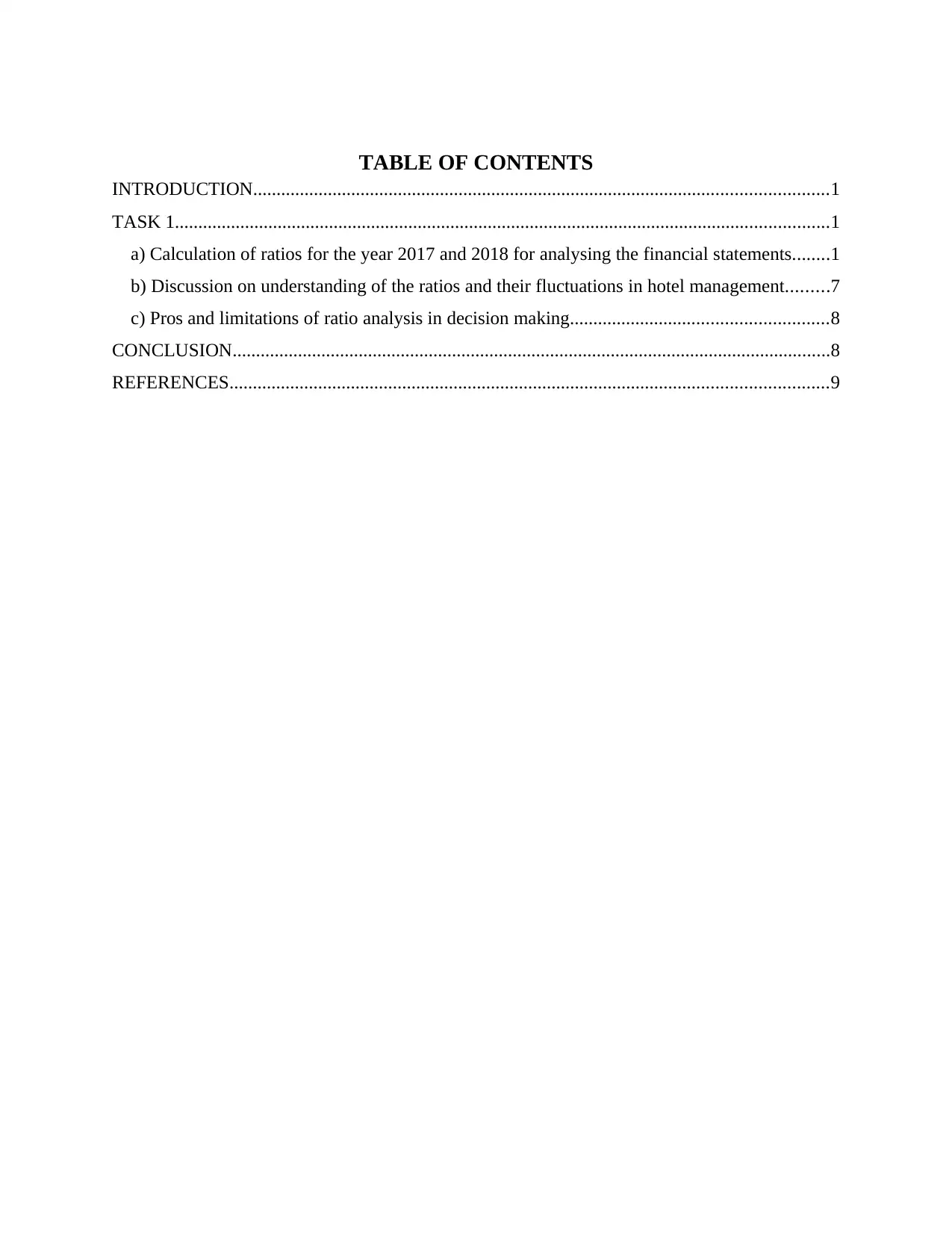
TABLE OF CONTENTS
INTRODUCTION...........................................................................................................................1
TASK 1............................................................................................................................................1
a) Calculation of ratios for the year 2017 and 2018 for analysing the financial statements........1
b) Discussion on understanding of the ratios and their fluctuations in hotel management.........7
c) Pros and limitations of ratio analysis in decision making.......................................................8
CONCLUSION................................................................................................................................8
REFERENCES................................................................................................................................9
INTRODUCTION...........................................................................................................................1
TASK 1............................................................................................................................................1
a) Calculation of ratios for the year 2017 and 2018 for analysing the financial statements........1
b) Discussion on understanding of the ratios and their fluctuations in hotel management.........7
c) Pros and limitations of ratio analysis in decision making.......................................................8
CONCLUSION................................................................................................................................8
REFERENCES................................................................................................................................9
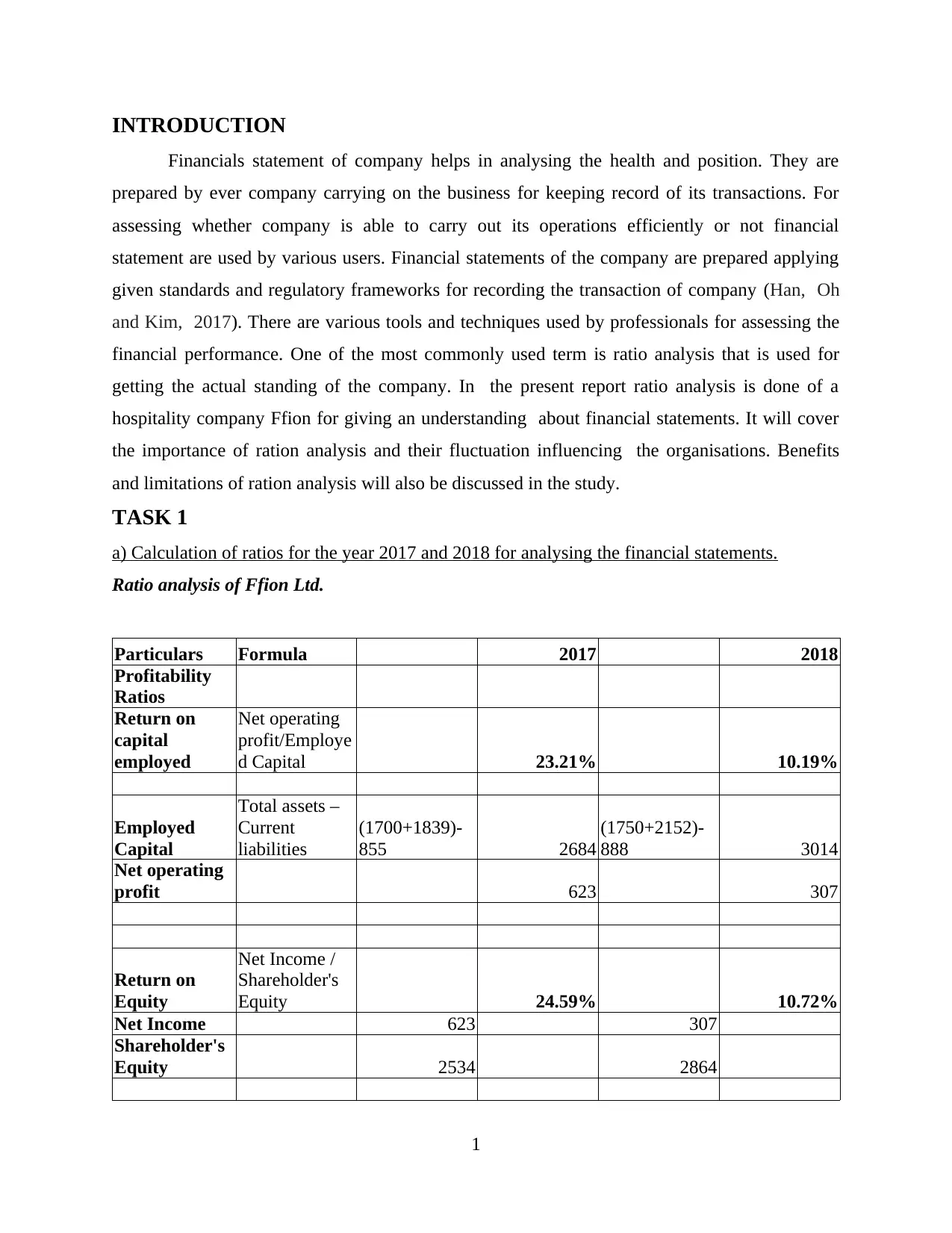
INTRODUCTION
Financials statement of company helps in analysing the health and position. They are
prepared by ever company carrying on the business for keeping record of its transactions. For
assessing whether company is able to carry out its operations efficiently or not financial
statement are used by various users. Financial statements of the company are prepared applying
given standards and regulatory frameworks for recording the transaction of company (Han, Oh
and Kim, 2017). There are various tools and techniques used by professionals for assessing the
financial performance. One of the most commonly used term is ratio analysis that is used for
getting the actual standing of the company. In the present report ratio analysis is done of a
hospitality company Ffion for giving an understanding about financial statements. It will cover
the importance of ration analysis and their fluctuation influencing the organisations. Benefits
and limitations of ration analysis will also be discussed in the study.
TASK 1
a) Calculation of ratios for the year 2017 and 2018 for analysing the financial statements.
Ratio analysis of Ffion Ltd.
Particulars Formula 2017 2018
Profitability
Ratios
Return on
capital
employed
Net operating
profit/Employe
d Capital 23.21% 10.19%
Employed
Capital
Total assets –
Current
liabilities
(1700+1839)-
855 2684
(1750+2152)-
888 3014
Net operating
profit 623 307
Return on
Equity
Net Income /
Shareholder's
Equity 24.59% 10.72%
Net Income 623 307
Shareholder's
Equity 2534 2864
1
Financials statement of company helps in analysing the health and position. They are
prepared by ever company carrying on the business for keeping record of its transactions. For
assessing whether company is able to carry out its operations efficiently or not financial
statement are used by various users. Financial statements of the company are prepared applying
given standards and regulatory frameworks for recording the transaction of company (Han, Oh
and Kim, 2017). There are various tools and techniques used by professionals for assessing the
financial performance. One of the most commonly used term is ratio analysis that is used for
getting the actual standing of the company. In the present report ratio analysis is done of a
hospitality company Ffion for giving an understanding about financial statements. It will cover
the importance of ration analysis and their fluctuation influencing the organisations. Benefits
and limitations of ration analysis will also be discussed in the study.
TASK 1
a) Calculation of ratios for the year 2017 and 2018 for analysing the financial statements.
Ratio analysis of Ffion Ltd.
Particulars Formula 2017 2018
Profitability
Ratios
Return on
capital
employed
Net operating
profit/Employe
d Capital 23.21% 10.19%
Employed
Capital
Total assets –
Current
liabilities
(1700+1839)-
855 2684
(1750+2152)-
888 3014
Net operating
profit 623 307
Return on
Equity
Net Income /
Shareholder's
Equity 24.59% 10.72%
Net Income 623 307
Shareholder's
Equity 2534 2864
1
⊘ This is a preview!⊘
Do you want full access?
Subscribe today to unlock all pages.

Trusted by 1+ million students worldwide
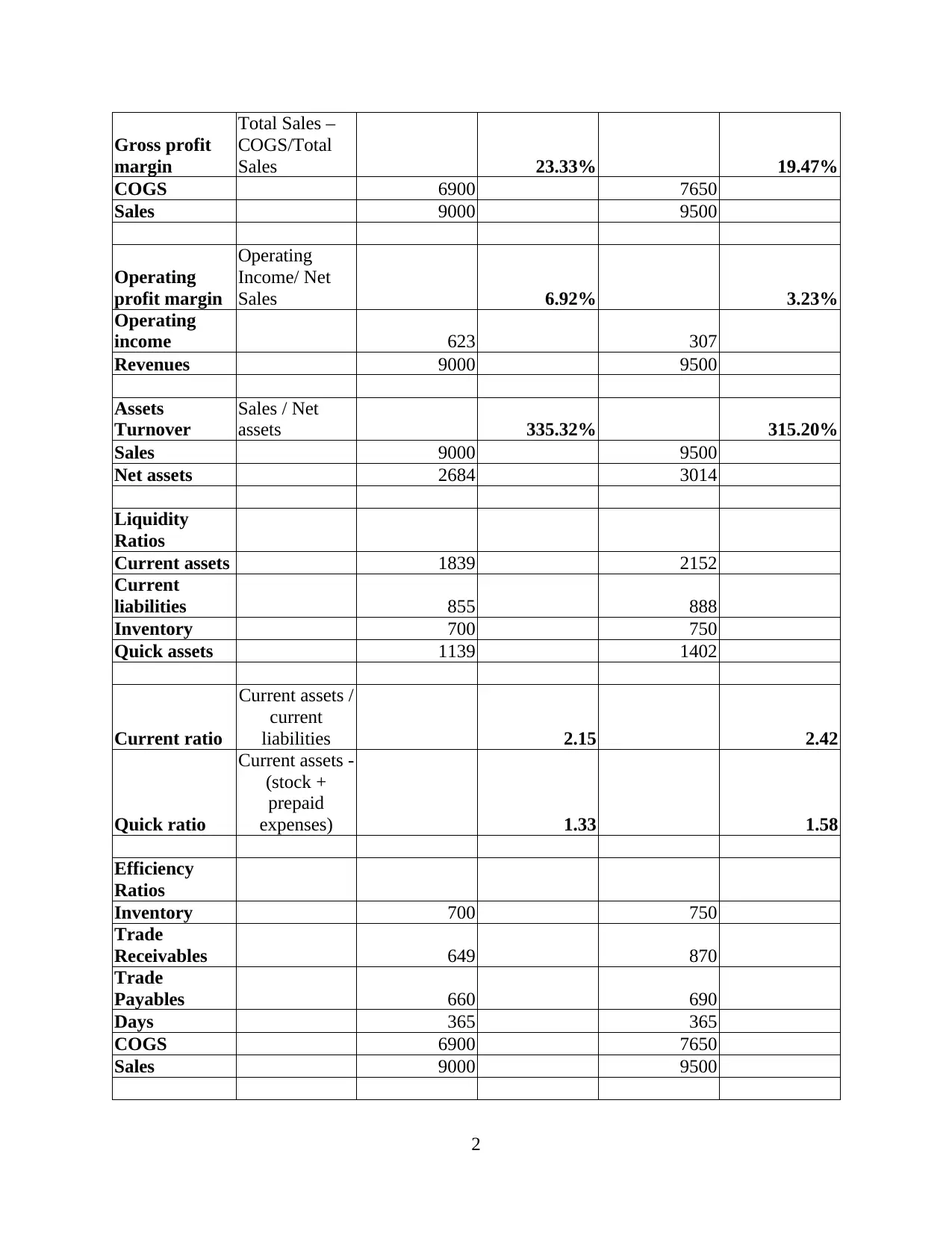
Gross profit
margin
Total Sales –
COGS/Total
Sales 23.33% 19.47%
COGS 6900 7650
Sales 9000 9500
Operating
profit margin
Operating
Income/ Net
Sales 6.92% 3.23%
Operating
income 623 307
Revenues 9000 9500
Assets
Turnover
Sales / Net
assets 335.32% 315.20%
Sales 9000 9500
Net assets 2684 3014
Liquidity
Ratios
Current assets 1839 2152
Current
liabilities 855 888
Inventory 700 750
Quick assets 1139 1402
Current ratio
Current assets /
current
liabilities 2.15 2.42
Quick ratio
Current assets -
(stock +
prepaid
expenses) 1.33 1.58
Efficiency
Ratios
Inventory 700 750
Trade
Receivables 649 870
Trade
Payables 660 690
Days 365 365
COGS 6900 7650
Sales 9000 9500
2
margin
Total Sales –
COGS/Total
Sales 23.33% 19.47%
COGS 6900 7650
Sales 9000 9500
Operating
profit margin
Operating
Income/ Net
Sales 6.92% 3.23%
Operating
income 623 307
Revenues 9000 9500
Assets
Turnover
Sales / Net
assets 335.32% 315.20%
Sales 9000 9500
Net assets 2684 3014
Liquidity
Ratios
Current assets 1839 2152
Current
liabilities 855 888
Inventory 700 750
Quick assets 1139 1402
Current ratio
Current assets /
current
liabilities 2.15 2.42
Quick ratio
Current assets -
(stock +
prepaid
expenses) 1.33 1.58
Efficiency
Ratios
Inventory 700 750
Trade
Receivables 649 870
Trade
Payables 660 690
Days 365 365
COGS 6900 7650
Sales 9000 9500
2
Paraphrase This Document
Need a fresh take? Get an instant paraphrase of this document with our AI Paraphraser
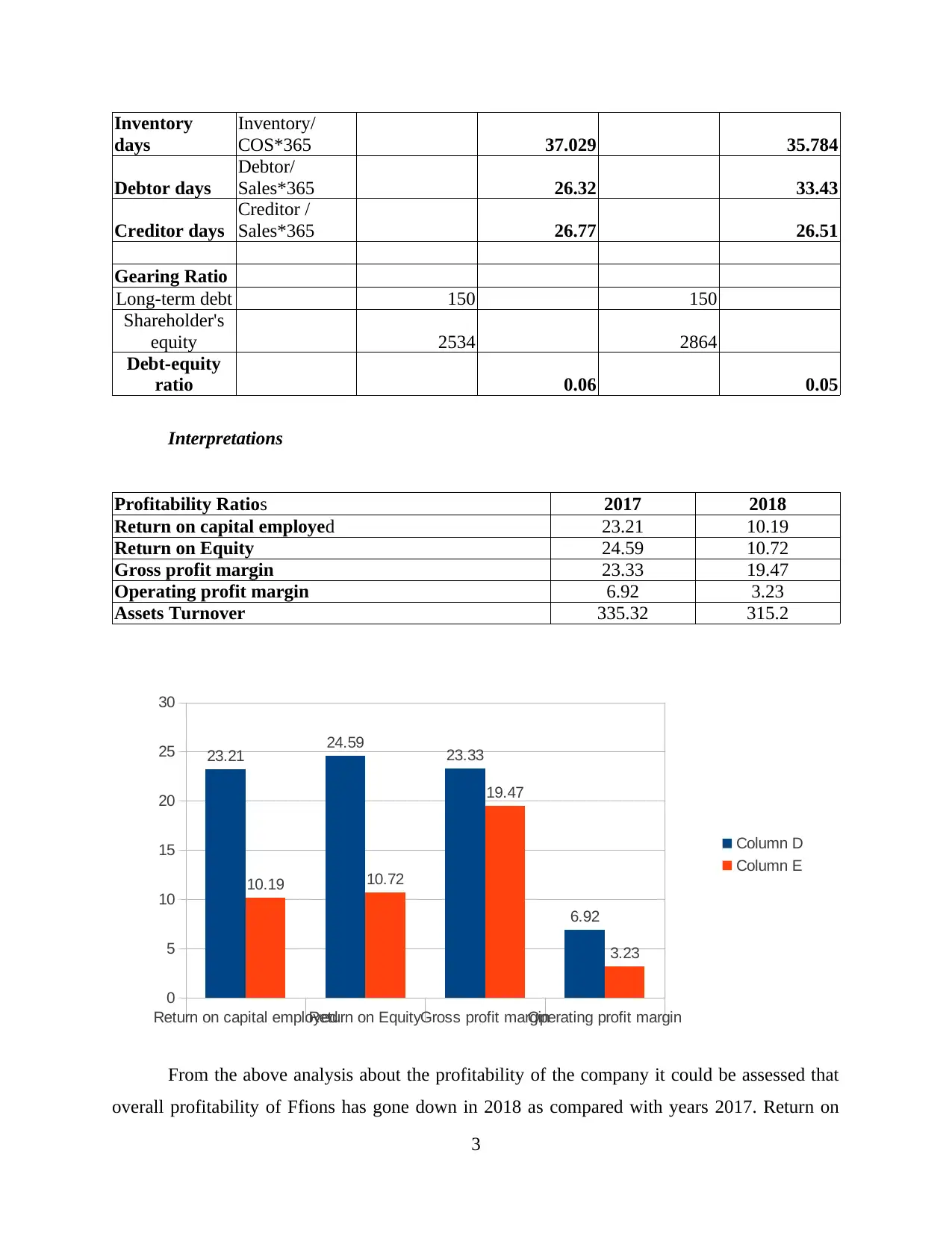
Inventory
days
Inventory/
COS*365 37.029 35.784
Debtor days
Debtor/
Sales*365 26.32 33.43
Creditor days
Creditor /
Sales*365 26.77 26.51
Gearing Ratio
Long-term debt 150 150
Shareholder's
equity 2534 2864
Debt-equity
ratio 0.06 0.05
Interpretations
Profitability Ratios 2017 2018
Return on capital employed 23.21 10.19
Return on Equity 24.59 10.72
Gross profit margin 23.33 19.47
Operating profit margin 6.92 3.23
Assets Turnover 335.32 315.2
Return on capital employedReturn on EquityGross profit marginOperating profit margin
0
5
10
15
20
25
30
23.21 24.59 23.33
6.92
10.19 10.72
19.47
3.23
Column D
Column E
From the above analysis about the profitability of the company it could be assessed that
overall profitability of Ffions has gone down in 2018 as compared with years 2017. Return on
3
days
Inventory/
COS*365 37.029 35.784
Debtor days
Debtor/
Sales*365 26.32 33.43
Creditor days
Creditor /
Sales*365 26.77 26.51
Gearing Ratio
Long-term debt 150 150
Shareholder's
equity 2534 2864
Debt-equity
ratio 0.06 0.05
Interpretations
Profitability Ratios 2017 2018
Return on capital employed 23.21 10.19
Return on Equity 24.59 10.72
Gross profit margin 23.33 19.47
Operating profit margin 6.92 3.23
Assets Turnover 335.32 315.2
Return on capital employedReturn on EquityGross profit marginOperating profit margin
0
5
10
15
20
25
30
23.21 24.59 23.33
6.92
10.19 10.72
19.47
3.23
Column D
Column E
From the above analysis about the profitability of the company it could be assessed that
overall profitability of Ffions has gone down in 2018 as compared with years 2017. Return on
3
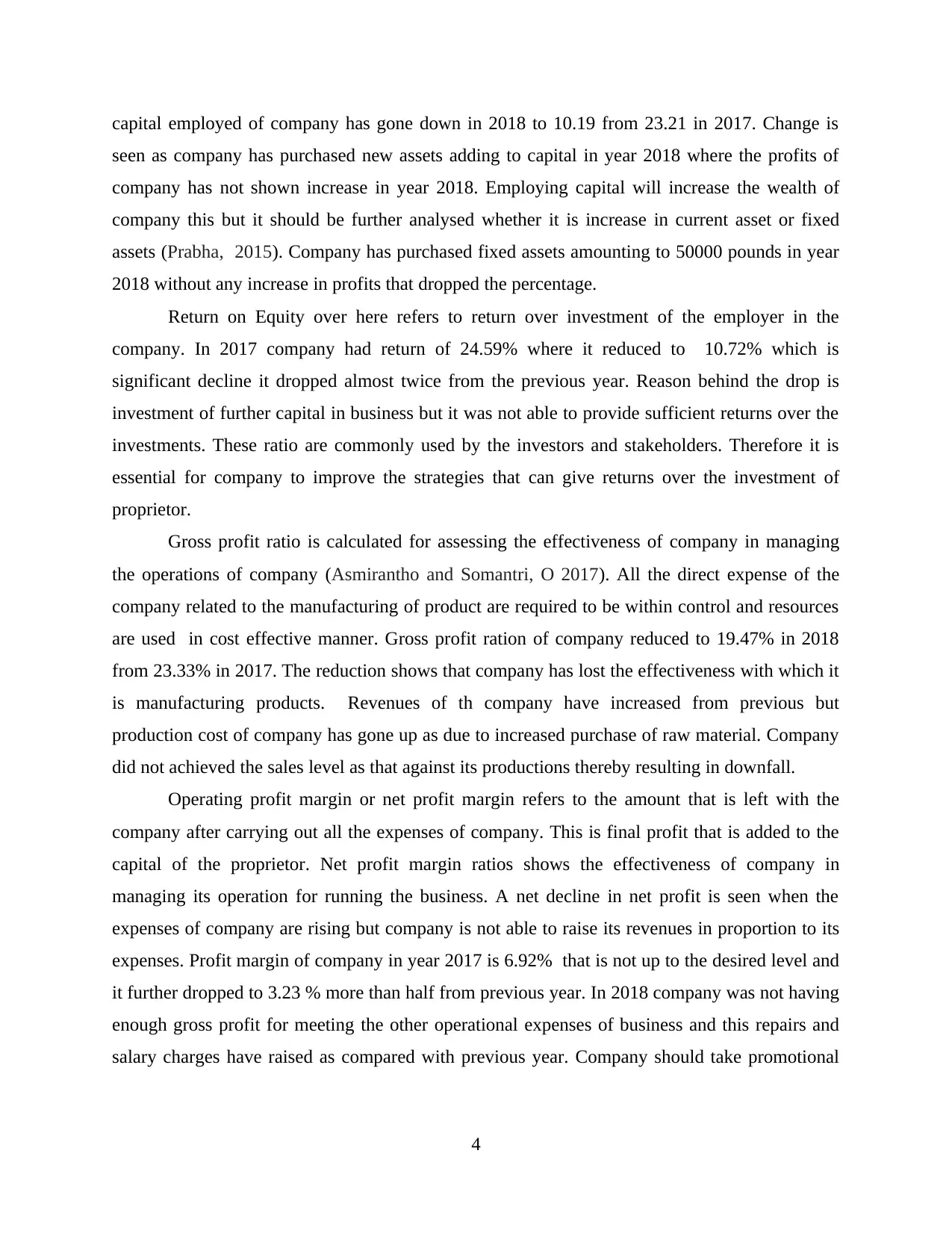
capital employed of company has gone down in 2018 to 10.19 from 23.21 in 2017. Change is
seen as company has purchased new assets adding to capital in year 2018 where the profits of
company has not shown increase in year 2018. Employing capital will increase the wealth of
company this but it should be further analysed whether it is increase in current asset or fixed
assets (Prabha, 2015). Company has purchased fixed assets amounting to 50000 pounds in year
2018 without any increase in profits that dropped the percentage.
Return on Equity over here refers to return over investment of the employer in the
company. In 2017 company had return of 24.59% where it reduced to 10.72% which is
significant decline it dropped almost twice from the previous year. Reason behind the drop is
investment of further capital in business but it was not able to provide sufficient returns over the
investments. These ratio are commonly used by the investors and stakeholders. Therefore it is
essential for company to improve the strategies that can give returns over the investment of
proprietor.
Gross profit ratio is calculated for assessing the effectiveness of company in managing
the operations of company (Asmirantho and Somantri, O 2017). All the direct expense of the
company related to the manufacturing of product are required to be within control and resources
are used in cost effective manner. Gross profit ration of company reduced to 19.47% in 2018
from 23.33% in 2017. The reduction shows that company has lost the effectiveness with which it
is manufacturing products. Revenues of th company have increased from previous but
production cost of company has gone up as due to increased purchase of raw material. Company
did not achieved the sales level as that against its productions thereby resulting in downfall.
Operating profit margin or net profit margin refers to the amount that is left with the
company after carrying out all the expenses of company. This is final profit that is added to the
capital of the proprietor. Net profit margin ratios shows the effectiveness of company in
managing its operation for running the business. A net decline in net profit is seen when the
expenses of company are rising but company is not able to raise its revenues in proportion to its
expenses. Profit margin of company in year 2017 is 6.92% that is not up to the desired level and
it further dropped to 3.23 % more than half from previous year. In 2018 company was not having
enough gross profit for meeting the other operational expenses of business and this repairs and
salary charges have raised as compared with previous year. Company should take promotional
4
seen as company has purchased new assets adding to capital in year 2018 where the profits of
company has not shown increase in year 2018. Employing capital will increase the wealth of
company this but it should be further analysed whether it is increase in current asset or fixed
assets (Prabha, 2015). Company has purchased fixed assets amounting to 50000 pounds in year
2018 without any increase in profits that dropped the percentage.
Return on Equity over here refers to return over investment of the employer in the
company. In 2017 company had return of 24.59% where it reduced to 10.72% which is
significant decline it dropped almost twice from the previous year. Reason behind the drop is
investment of further capital in business but it was not able to provide sufficient returns over the
investments. These ratio are commonly used by the investors and stakeholders. Therefore it is
essential for company to improve the strategies that can give returns over the investment of
proprietor.
Gross profit ratio is calculated for assessing the effectiveness of company in managing
the operations of company (Asmirantho and Somantri, O 2017). All the direct expense of the
company related to the manufacturing of product are required to be within control and resources
are used in cost effective manner. Gross profit ration of company reduced to 19.47% in 2018
from 23.33% in 2017. The reduction shows that company has lost the effectiveness with which it
is manufacturing products. Revenues of th company have increased from previous but
production cost of company has gone up as due to increased purchase of raw material. Company
did not achieved the sales level as that against its productions thereby resulting in downfall.
Operating profit margin or net profit margin refers to the amount that is left with the
company after carrying out all the expenses of company. This is final profit that is added to the
capital of the proprietor. Net profit margin ratios shows the effectiveness of company in
managing its operation for running the business. A net decline in net profit is seen when the
expenses of company are rising but company is not able to raise its revenues in proportion to its
expenses. Profit margin of company in year 2017 is 6.92% that is not up to the desired level and
it further dropped to 3.23 % more than half from previous year. In 2018 company was not having
enough gross profit for meeting the other operational expenses of business and this repairs and
salary charges have raised as compared with previous year. Company should take promotional
4
⊘ This is a preview!⊘
Do you want full access?
Subscribe today to unlock all pages.

Trusted by 1+ million students worldwide
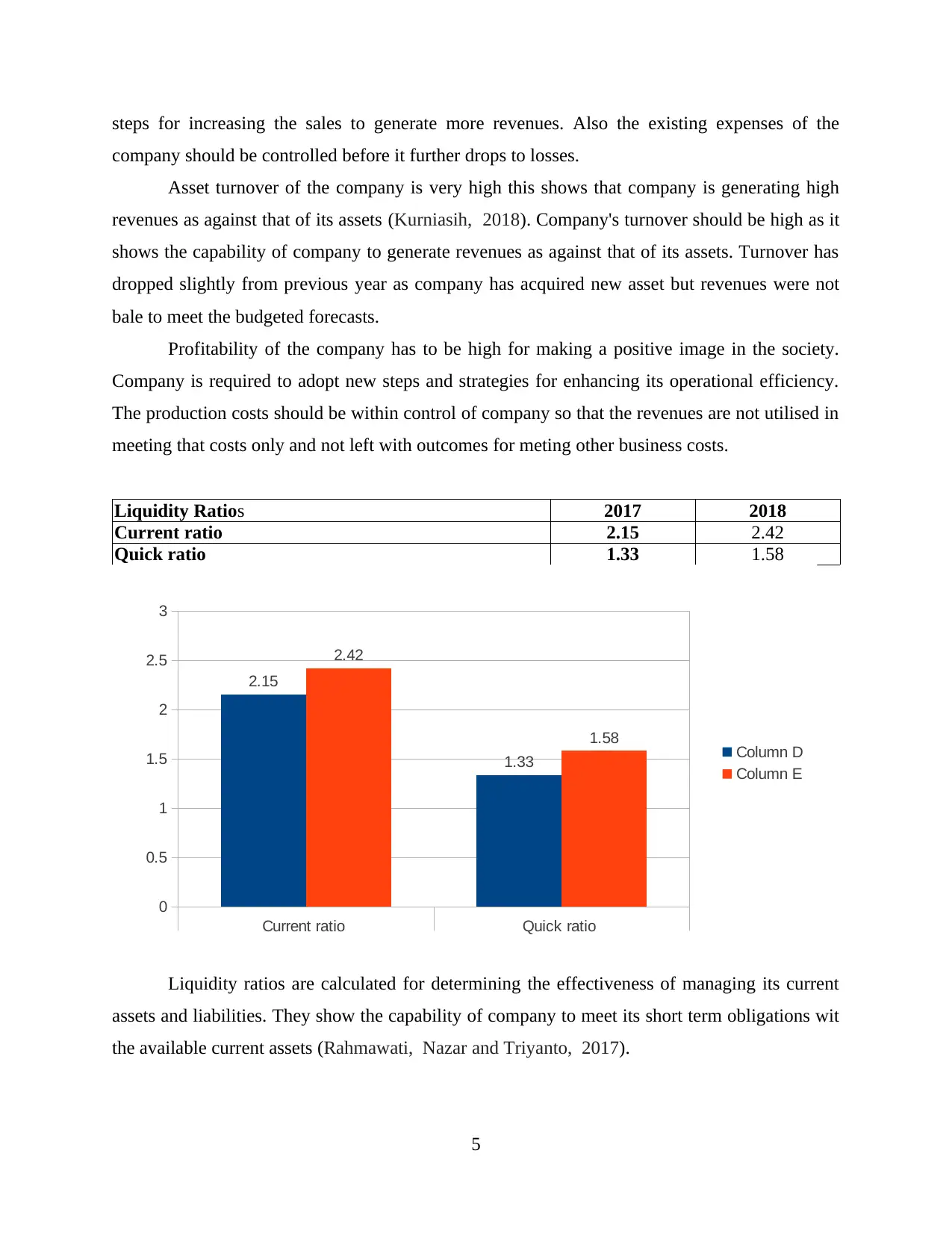
steps for increasing the sales to generate more revenues. Also the existing expenses of the
company should be controlled before it further drops to losses.
Asset turnover of the company is very high this shows that company is generating high
revenues as against that of its assets (Kurniasih, 2018). Company's turnover should be high as it
shows the capability of company to generate revenues as against that of its assets. Turnover has
dropped slightly from previous year as company has acquired new asset but revenues were not
bale to meet the budgeted forecasts.
Profitability of the company has to be high for making a positive image in the society.
Company is required to adopt new steps and strategies for enhancing its operational efficiency.
The production costs should be within control of company so that the revenues are not utilised in
meeting that costs only and not left with outcomes for meting other business costs.
Liquidity Ratios 2017 2018
Current ratio 2.15 2.42
Quick ratio 1.33 1.58
Current ratio Quick ratio
0
0.5
1
1.5
2
2.5
3
2.15
1.33
2.42
1.58 Column D
Column E
Liquidity ratios are calculated for determining the effectiveness of managing its current
assets and liabilities. They show the capability of company to meet its short term obligations wit
the available current assets (Rahmawati, Nazar and Triyanto, 2017).
5
company should be controlled before it further drops to losses.
Asset turnover of the company is very high this shows that company is generating high
revenues as against that of its assets (Kurniasih, 2018). Company's turnover should be high as it
shows the capability of company to generate revenues as against that of its assets. Turnover has
dropped slightly from previous year as company has acquired new asset but revenues were not
bale to meet the budgeted forecasts.
Profitability of the company has to be high for making a positive image in the society.
Company is required to adopt new steps and strategies for enhancing its operational efficiency.
The production costs should be within control of company so that the revenues are not utilised in
meeting that costs only and not left with outcomes for meting other business costs.
Liquidity Ratios 2017 2018
Current ratio 2.15 2.42
Quick ratio 1.33 1.58
Current ratio Quick ratio
0
0.5
1
1.5
2
2.5
3
2.15
1.33
2.42
1.58 Column D
Column E
Liquidity ratios are calculated for determining the effectiveness of managing its current
assets and liabilities. They show the capability of company to meet its short term obligations wit
the available current assets (Rahmawati, Nazar and Triyanto, 2017).
5
Paraphrase This Document
Need a fresh take? Get an instant paraphrase of this document with our AI Paraphraser
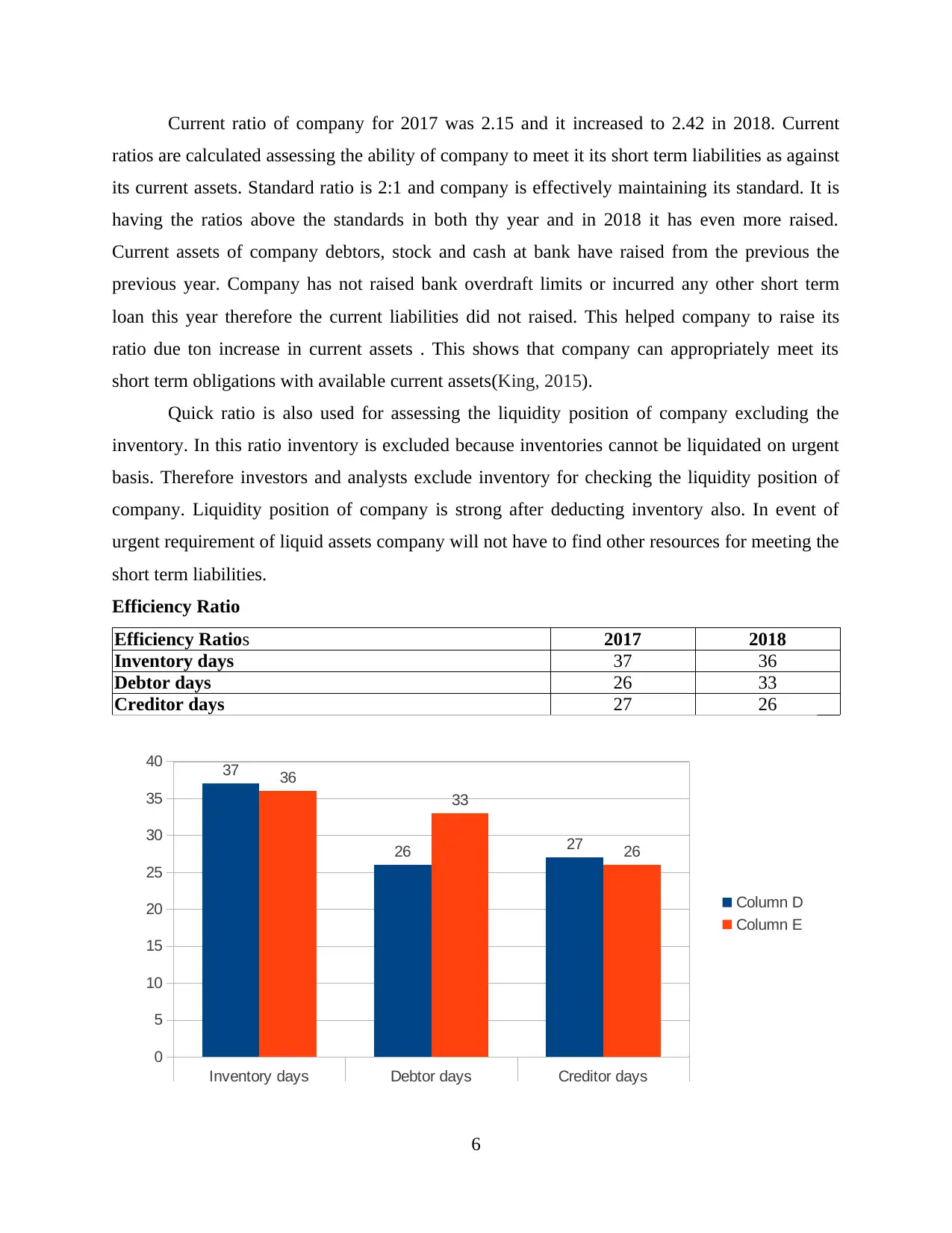
Current ratio of company for 2017 was 2.15 and it increased to 2.42 in 2018. Current
ratios are calculated assessing the ability of company to meet it its short term liabilities as against
its current assets. Standard ratio is 2:1 and company is effectively maintaining its standard. It is
having the ratios above the standards in both thy year and in 2018 it has even more raised.
Current assets of company debtors, stock and cash at bank have raised from the previous the
previous year. Company has not raised bank overdraft limits or incurred any other short term
loan this year therefore the current liabilities did not raised. This helped company to raise its
ratio due ton increase in current assets . This shows that company can appropriately meet its
short term obligations with available current assets(King, 2015).
Quick ratio is also used for assessing the liquidity position of company excluding the
inventory. In this ratio inventory is excluded because inventories cannot be liquidated on urgent
basis. Therefore investors and analysts exclude inventory for checking the liquidity position of
company. Liquidity position of company is strong after deducting inventory also. In event of
urgent requirement of liquid assets company will not have to find other resources for meeting the
short term liabilities.
Efficiency Ratio
Efficiency Ratios 2017 2018
Inventory days 37 36
Debtor days 26 33
Creditor days 27 26
Inventory days Debtor days Creditor days
0
5
10
15
20
25
30
35
40 37
26 27
36
33
26
Column D
Column E
6
ratios are calculated assessing the ability of company to meet it its short term liabilities as against
its current assets. Standard ratio is 2:1 and company is effectively maintaining its standard. It is
having the ratios above the standards in both thy year and in 2018 it has even more raised.
Current assets of company debtors, stock and cash at bank have raised from the previous the
previous year. Company has not raised bank overdraft limits or incurred any other short term
loan this year therefore the current liabilities did not raised. This helped company to raise its
ratio due ton increase in current assets . This shows that company can appropriately meet its
short term obligations with available current assets(King, 2015).
Quick ratio is also used for assessing the liquidity position of company excluding the
inventory. In this ratio inventory is excluded because inventories cannot be liquidated on urgent
basis. Therefore investors and analysts exclude inventory for checking the liquidity position of
company. Liquidity position of company is strong after deducting inventory also. In event of
urgent requirement of liquid assets company will not have to find other resources for meeting the
short term liabilities.
Efficiency Ratio
Efficiency Ratios 2017 2018
Inventory days 37 36
Debtor days 26 33
Creditor days 27 26
Inventory days Debtor days Creditor days
0
5
10
15
20
25
30
35
40 37
26 27
36
33
26
Column D
Column E
6
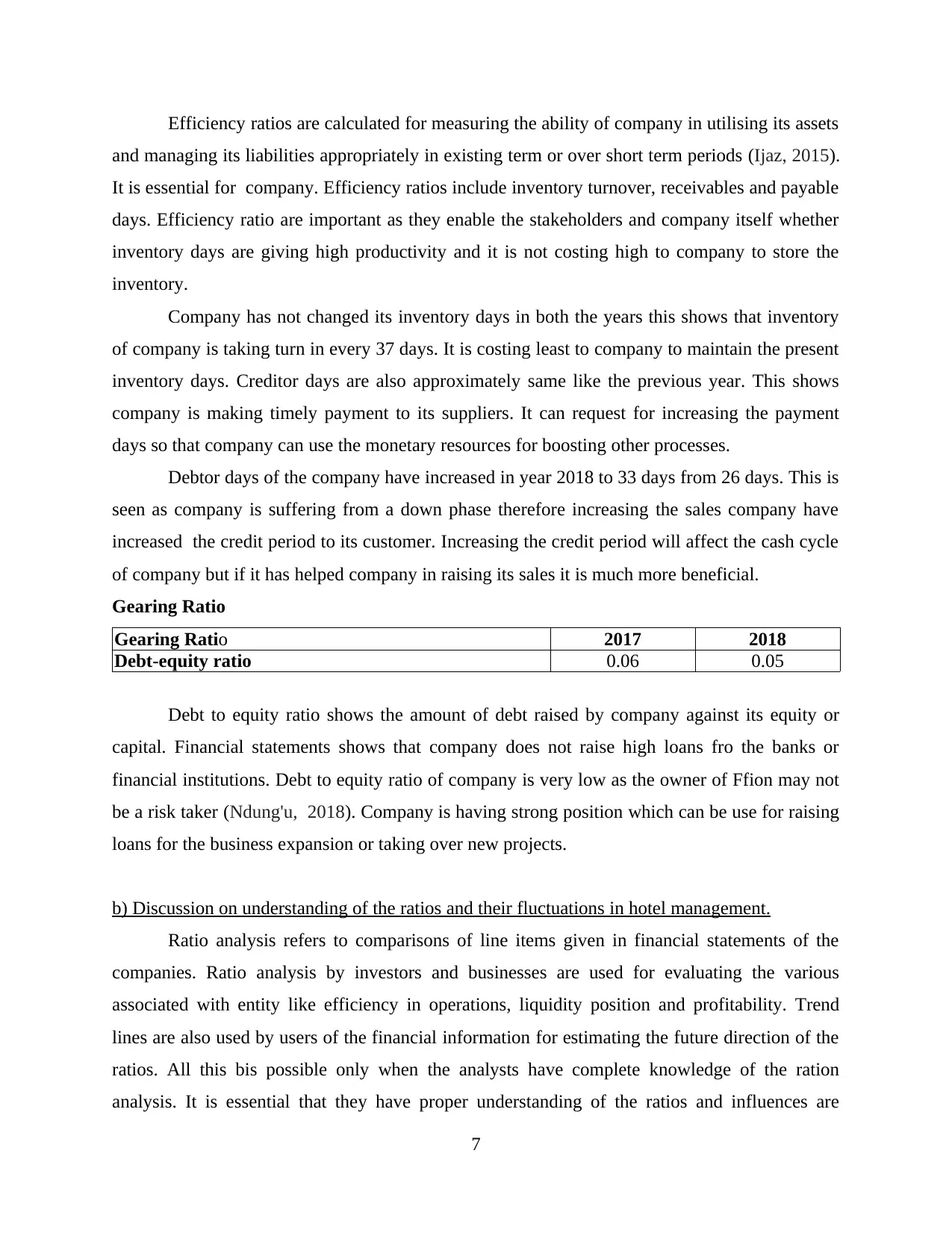
Efficiency ratios are calculated for measuring the ability of company in utilising its assets
and managing its liabilities appropriately in existing term or over short term periods (Ijaz, 2015).
It is essential for company. Efficiency ratios include inventory turnover, receivables and payable
days. Efficiency ratio are important as they enable the stakeholders and company itself whether
inventory days are giving high productivity and it is not costing high to company to store the
inventory.
Company has not changed its inventory days in both the years this shows that inventory
of company is taking turn in every 37 days. It is costing least to company to maintain the present
inventory days. Creditor days are also approximately same like the previous year. This shows
company is making timely payment to its suppliers. It can request for increasing the payment
days so that company can use the monetary resources for boosting other processes.
Debtor days of the company have increased in year 2018 to 33 days from 26 days. This is
seen as company is suffering from a down phase therefore increasing the sales company have
increased the credit period to its customer. Increasing the credit period will affect the cash cycle
of company but if it has helped company in raising its sales it is much more beneficial.
Gearing Ratio
Gearing Ratio 2017 2018
Debt-equity ratio 0.06 0.05
Debt to equity ratio shows the amount of debt raised by company against its equity or
capital. Financial statements shows that company does not raise high loans fro the banks or
financial institutions. Debt to equity ratio of company is very low as the owner of Ffion may not
be a risk taker (Ndung'u, 2018). Company is having strong position which can be use for raising
loans for the business expansion or taking over new projects.
b) Discussion on understanding of the ratios and their fluctuations in hotel management.
Ratio analysis refers to comparisons of line items given in financial statements of the
companies. Ratio analysis by investors and businesses are used for evaluating the various
associated with entity like efficiency in operations, liquidity position and profitability. Trend
lines are also used by users of the financial information for estimating the future direction of the
ratios. All this bis possible only when the analysts have complete knowledge of the ration
analysis. It is essential that they have proper understanding of the ratios and influences are
7
and managing its liabilities appropriately in existing term or over short term periods (Ijaz, 2015).
It is essential for company. Efficiency ratios include inventory turnover, receivables and payable
days. Efficiency ratio are important as they enable the stakeholders and company itself whether
inventory days are giving high productivity and it is not costing high to company to store the
inventory.
Company has not changed its inventory days in both the years this shows that inventory
of company is taking turn in every 37 days. It is costing least to company to maintain the present
inventory days. Creditor days are also approximately same like the previous year. This shows
company is making timely payment to its suppliers. It can request for increasing the payment
days so that company can use the monetary resources for boosting other processes.
Debtor days of the company have increased in year 2018 to 33 days from 26 days. This is
seen as company is suffering from a down phase therefore increasing the sales company have
increased the credit period to its customer. Increasing the credit period will affect the cash cycle
of company but if it has helped company in raising its sales it is much more beneficial.
Gearing Ratio
Gearing Ratio 2017 2018
Debt-equity ratio 0.06 0.05
Debt to equity ratio shows the amount of debt raised by company against its equity or
capital. Financial statements shows that company does not raise high loans fro the banks or
financial institutions. Debt to equity ratio of company is very low as the owner of Ffion may not
be a risk taker (Ndung'u, 2018). Company is having strong position which can be use for raising
loans for the business expansion or taking over new projects.
b) Discussion on understanding of the ratios and their fluctuations in hotel management.
Ratio analysis refers to comparisons of line items given in financial statements of the
companies. Ratio analysis by investors and businesses are used for evaluating the various
associated with entity like efficiency in operations, liquidity position and profitability. Trend
lines are also used by users of the financial information for estimating the future direction of the
ratios. All this bis possible only when the analysts have complete knowledge of the ration
analysis. It is essential that they have proper understanding of the ratios and influences are
7
⊘ This is a preview!⊘
Do you want full access?
Subscribe today to unlock all pages.

Trusted by 1+ million students worldwide
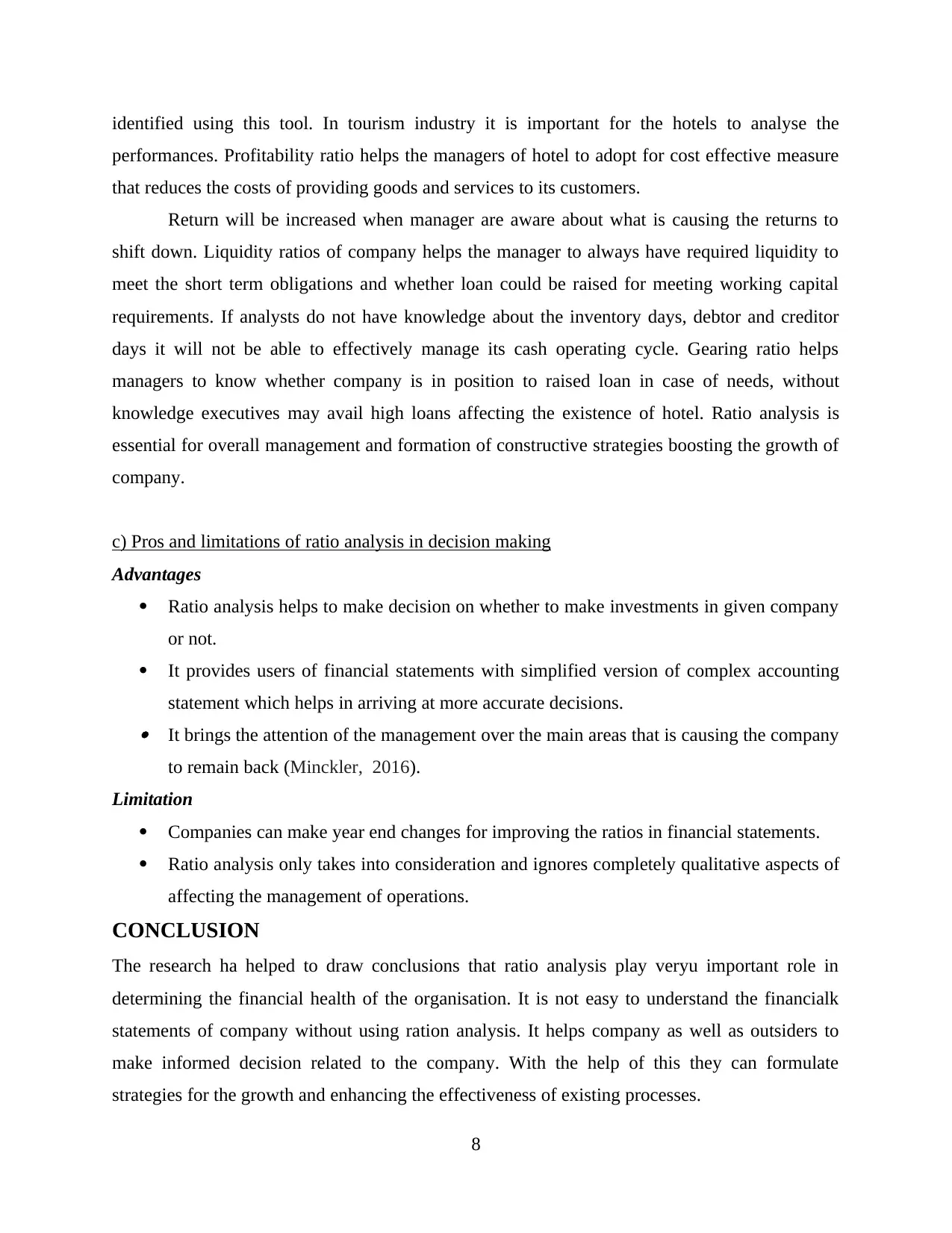
identified using this tool. In tourism industry it is important for the hotels to analyse the
performances. Profitability ratio helps the managers of hotel to adopt for cost effective measure
that reduces the costs of providing goods and services to its customers.
Return will be increased when manager are aware about what is causing the returns to
shift down. Liquidity ratios of company helps the manager to always have required liquidity to
meet the short term obligations and whether loan could be raised for meeting working capital
requirements. If analysts do not have knowledge about the inventory days, debtor and creditor
days it will not be able to effectively manage its cash operating cycle. Gearing ratio helps
managers to know whether company is in position to raised loan in case of needs, without
knowledge executives may avail high loans affecting the existence of hotel. Ratio analysis is
essential for overall management and formation of constructive strategies boosting the growth of
company.
c) Pros and limitations of ratio analysis in decision making
Advantages
Ratio analysis helps to make decision on whether to make investments in given company
or not.
It provides users of financial statements with simplified version of complex accounting
statement which helps in arriving at more accurate decisions. It brings the attention of the management over the main areas that is causing the company
to remain back (Minckler, 2016).
Limitation
Companies can make year end changes for improving the ratios in financial statements.
Ratio analysis only takes into consideration and ignores completely qualitative aspects of
affecting the management of operations.
CONCLUSION
The research ha helped to draw conclusions that ratio analysis play veryu important role in
determining the financial health of the organisation. It is not easy to understand the financialk
statements of company without using ration analysis. It helps company as well as outsiders to
make informed decision related to the company. With the help of this they can formulate
strategies for the growth and enhancing the effectiveness of existing processes.
8
performances. Profitability ratio helps the managers of hotel to adopt for cost effective measure
that reduces the costs of providing goods and services to its customers.
Return will be increased when manager are aware about what is causing the returns to
shift down. Liquidity ratios of company helps the manager to always have required liquidity to
meet the short term obligations and whether loan could be raised for meeting working capital
requirements. If analysts do not have knowledge about the inventory days, debtor and creditor
days it will not be able to effectively manage its cash operating cycle. Gearing ratio helps
managers to know whether company is in position to raised loan in case of needs, without
knowledge executives may avail high loans affecting the existence of hotel. Ratio analysis is
essential for overall management and formation of constructive strategies boosting the growth of
company.
c) Pros and limitations of ratio analysis in decision making
Advantages
Ratio analysis helps to make decision on whether to make investments in given company
or not.
It provides users of financial statements with simplified version of complex accounting
statement which helps in arriving at more accurate decisions. It brings the attention of the management over the main areas that is causing the company
to remain back (Minckler, 2016).
Limitation
Companies can make year end changes for improving the ratios in financial statements.
Ratio analysis only takes into consideration and ignores completely qualitative aspects of
affecting the management of operations.
CONCLUSION
The research ha helped to draw conclusions that ratio analysis play veryu important role in
determining the financial health of the organisation. It is not easy to understand the financialk
statements of company without using ration analysis. It helps company as well as outsiders to
make informed decision related to the company. With the help of this they can formulate
strategies for the growth and enhancing the effectiveness of existing processes.
8
Paraphrase This Document
Need a fresh take? Get an instant paraphrase of this document with our AI Paraphraser
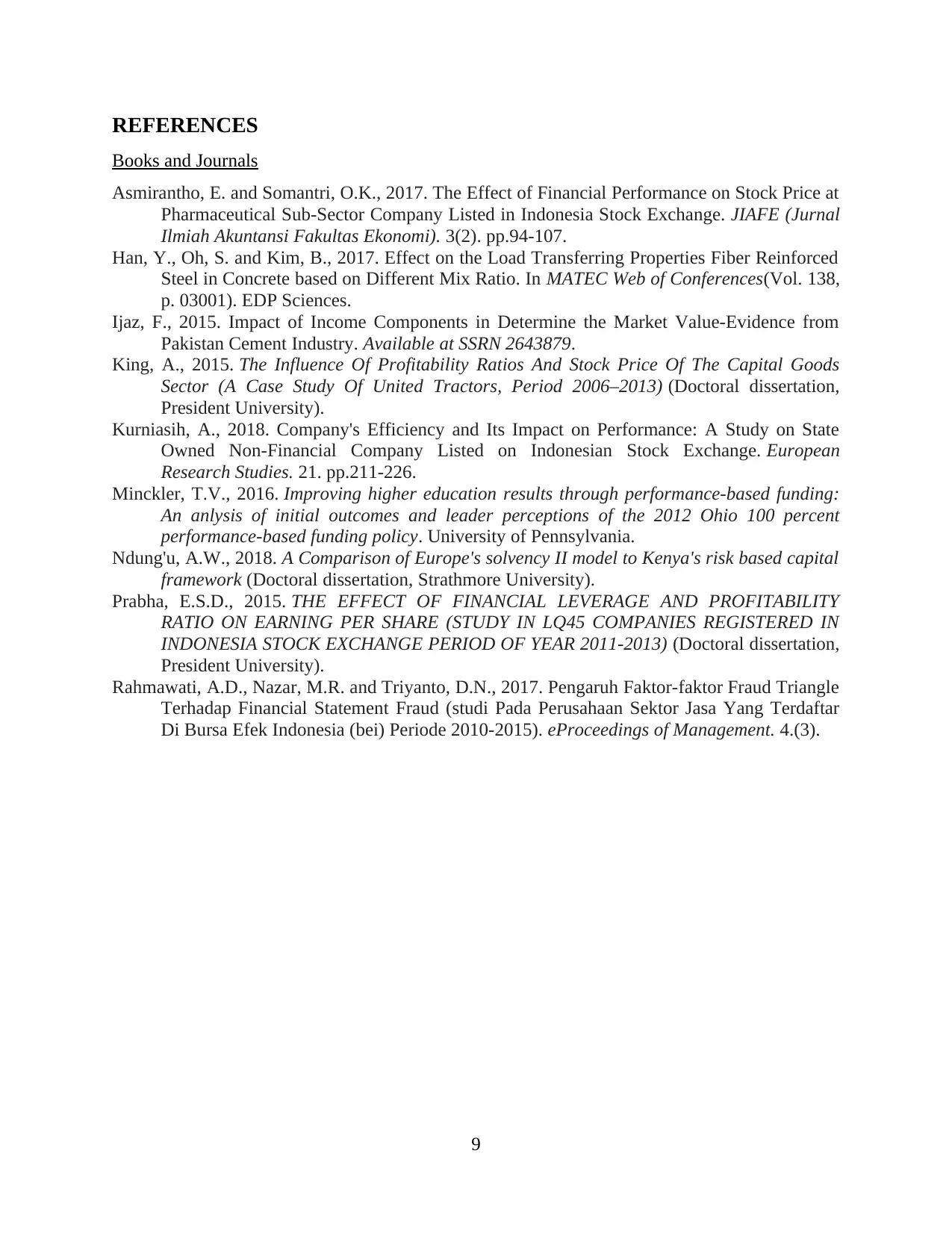
REFERENCES
Books and Journals
Asmirantho, E. and Somantri, O.K., 2017. The Effect of Financial Performance on Stock Price at
Pharmaceutical Sub-Sector Company Listed in Indonesia Stock Exchange. JIAFE (Jurnal
Ilmiah Akuntansi Fakultas Ekonomi). 3(2). pp.94-107.
Han, Y., Oh, S. and Kim, B., 2017. Effect on the Load Transferring Properties Fiber Reinforced
Steel in Concrete based on Different Mix Ratio. In MATEC Web of Conferences(Vol. 138,
p. 03001). EDP Sciences.
Ijaz, F., 2015. Impact of Income Components in Determine the Market Value-Evidence from
Pakistan Cement Industry. Available at SSRN 2643879.
King, A., 2015. The Influence Of Profitability Ratios And Stock Price Of The Capital Goods
Sector (A Case Study Of United Tractors, Period 2006–2013) (Doctoral dissertation,
President University).
Kurniasih, A., 2018. Company's Efficiency and Its Impact on Performance: A Study on State
Owned Non-Financial Company Listed on Indonesian Stock Exchange. European
Research Studies. 21. pp.211-226.
Minckler, T.V., 2016. Improving higher education results through performance-based funding:
An anlysis of initial outcomes and leader perceptions of the 2012 Ohio 100 percent
performance-based funding policy. University of Pennsylvania.
Ndung'u, A.W., 2018. A Comparison of Europe's solvency II model to Kenya's risk based capital
framework (Doctoral dissertation, Strathmore University).
Prabha, E.S.D., 2015. THE EFFECT OF FINANCIAL LEVERAGE AND PROFITABILITY
RATIO ON EARNING PER SHARE (STUDY IN LQ45 COMPANIES REGISTERED IN
INDONESIA STOCK EXCHANGE PERIOD OF YEAR 2011-2013) (Doctoral dissertation,
President University).
Rahmawati, A.D., Nazar, M.R. and Triyanto, D.N., 2017. Pengaruh Faktor-faktor Fraud Triangle
Terhadap Financial Statement Fraud (studi Pada Perusahaan Sektor Jasa Yang Terdaftar
Di Bursa Efek Indonesia (bei) Periode 2010-2015). eProceedings of Management. 4.(3).
9
Books and Journals
Asmirantho, E. and Somantri, O.K., 2017. The Effect of Financial Performance on Stock Price at
Pharmaceutical Sub-Sector Company Listed in Indonesia Stock Exchange. JIAFE (Jurnal
Ilmiah Akuntansi Fakultas Ekonomi). 3(2). pp.94-107.
Han, Y., Oh, S. and Kim, B., 2017. Effect on the Load Transferring Properties Fiber Reinforced
Steel in Concrete based on Different Mix Ratio. In MATEC Web of Conferences(Vol. 138,
p. 03001). EDP Sciences.
Ijaz, F., 2015. Impact of Income Components in Determine the Market Value-Evidence from
Pakistan Cement Industry. Available at SSRN 2643879.
King, A., 2015. The Influence Of Profitability Ratios And Stock Price Of The Capital Goods
Sector (A Case Study Of United Tractors, Period 2006–2013) (Doctoral dissertation,
President University).
Kurniasih, A., 2018. Company's Efficiency and Its Impact on Performance: A Study on State
Owned Non-Financial Company Listed on Indonesian Stock Exchange. European
Research Studies. 21. pp.211-226.
Minckler, T.V., 2016. Improving higher education results through performance-based funding:
An anlysis of initial outcomes and leader perceptions of the 2012 Ohio 100 percent
performance-based funding policy. University of Pennsylvania.
Ndung'u, A.W., 2018. A Comparison of Europe's solvency II model to Kenya's risk based capital
framework (Doctoral dissertation, Strathmore University).
Prabha, E.S.D., 2015. THE EFFECT OF FINANCIAL LEVERAGE AND PROFITABILITY
RATIO ON EARNING PER SHARE (STUDY IN LQ45 COMPANIES REGISTERED IN
INDONESIA STOCK EXCHANGE PERIOD OF YEAR 2011-2013) (Doctoral dissertation,
President University).
Rahmawati, A.D., Nazar, M.R. and Triyanto, D.N., 2017. Pengaruh Faktor-faktor Fraud Triangle
Terhadap Financial Statement Fraud (studi Pada Perusahaan Sektor Jasa Yang Terdaftar
Di Bursa Efek Indonesia (bei) Periode 2010-2015). eProceedings of Management. 4.(3).
9
1 out of 11
Your All-in-One AI-Powered Toolkit for Academic Success.
+13062052269
info@desklib.com
Available 24*7 on WhatsApp / Email
![[object Object]](/_next/static/media/star-bottom.7253800d.svg)
Unlock your academic potential
Copyright © 2020–2025 A2Z Services. All Rights Reserved. Developed and managed by ZUCOL.